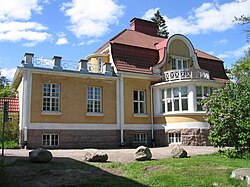Kauniainen
| |
|---|---|
Town | |
| Kauniaisten kaupunki Grankulla stad | |
 Villa Junghans in Kauniainen | |
 Location of Kauniainen in Finland | |
| Coordinates: 60°13′N 024°44′E / 60.217°N 24.733°E | |
| Country | |
| Region | |
| Sub-region | Helsinki sub-region |
| Metropolitan area | Helsinki metropolitan area |
| Charter | 1920[1] |
| City rights | 1972 |
| Government | |
| • Town manager | Christoffer Masar |
| Area (2018-01-01)[2] | |
• Total | 6.00 km2 (2.32 sq mi) |
| • Land | 5.89 km2 (2.27 sq mi) |
| • Water | 0.12 km2 (0.05 sq mi) |
| • Rank | 313th largest in Finland |
| Population (2024-08-31)[3] | |
• Total | 10,238 |
| • Rank | 94th largest in Finland |
| • Density | 1,738.2/km2 (4,502/sq mi) |
| Population by native language | |
| • Finnish | 58.7% (official) |
| • Swedish | 30.4% (official) |
| • Others | 10.8% |
| Population by age | |
| • 0 to 14 | 17.9% |
| • 15 to 64 | 60.4% |
| • 65 or older | 21.7% |
| Time zone | UTC+02:00 (EET) |
| • Summer (DST) | UTC+03:00 (EEST) |
| Climate | Dfb |
| Website | www.kauniainen.fi |
Kauniainen (Finnish: [ˈkɑu̯niˌɑi̯nen]; Swedish: Grankulla) is a town in Finland, located in the southern interior of the country. Kauniainen is situated in the southern part of the Uusimaa region, and it is enclaved by the City of Espoo. The population of Kauniainen is approximately 10,000. It is the 94th most populous municipality in Finland. Kaunianen is part of the Helsinki Metropolitan Area, which has approximately 1.6 million inhabitants.
Kauniainen was founded by a corporation in 1906, AB Grankulla, that parcelled land and created a suburb for villas; Kauniainen received the status of a market town in 1920,[1] the Finnish name in 1949 and the title of kaupunki ("city, town") in 1972.
The municipal taxation rate in Kauniainen is the lowest in Finland ([6]%), which has made the city attractive to high-income families. This in turn makes the average income generally high, making it possible to keep the taxation rate low without compromising the service to the inhabitants.
Kauniainen is a bilingual municipality with Finnish and Swedish as its official languages. The population consists of 59% Finnish speakers, 30% Swedish speakers, and 11% speakers of other languages. The dominant party in the city council has traditionally been the Swedish People's Party.
- ^ a b Cite error: The named reference
hswas invoked but never defined (see the help page). - ^ "Area of Finnish Municipalities 1.1.2018" (PDF). National Land Survey of Finland. Retrieved 30 January 2018.
- ^ "Finland's preliminary population figure was 5,625,011 at the end of August 2024". Population structure. Statistics Finland. 24 September 2024. ISSN 1797-5395. Retrieved 25 September 2024.
- ^ "Population growth biggest in nearly 70 years". Population structure. Statistics Finland. 26 April 2024. ISSN 1797-5395. Retrieved 29 April 2024.
- ^ "Population according to age (1-year) and sex by area and the regional division of each statistical reference year, 2003–2020". StatFin. Statistics Finland. Retrieved 2 May 2021.
- ^ a b c "Luettelo kuntien ja seurakuntien tuloveroprosenteista vuonna 2023". Tax Administration of Finland. 14 November 2022. Retrieved 7 May 2023.
